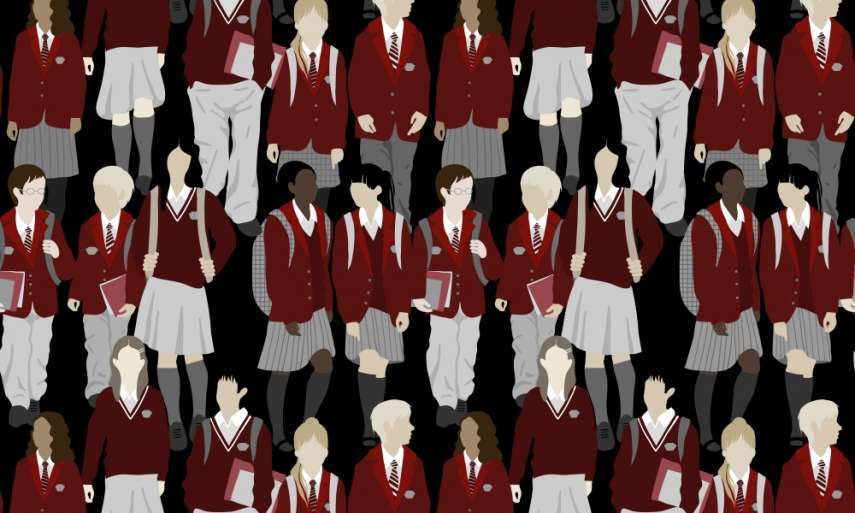From Teacher magazine, I'm Rebecca Vukovic, and you're listening to an episode in our Teaching Methods series.
My guest today is Lisa Seewraj, a teacher at Child Side Playgroup and School in Boyanup, Western Australia, about 200 kilometres south of Perth. Child Side School is an independent, co-educational school covering Kindergarten to Year 10.
The school was founded in 2002, with a focus on relationships, engagement and connectivity. The school's founders and co-principals Karron McDonald and Leonie O'Connell say they strongly believe that each person's story matters to them and should matter to the students themselves; they help children value their own story and communicate and advocate it's worth over and above any reports, grades, scores and other stats and data.
Lisa Seewraj teaches a multi-age class of 23 students across Years 7-10. She does this with a co-teacher who teaches maths and science, and the two teachers are in the class for most of the week. Lisa also teaches these students for the four years they are in this year range. In today's episode we discuss how she manages the classroom on a daily basis, the range of abilities that she caters for, and how she provides each student with the appropriate level of challenge to progress in their learning. Let's get started.
Rebecca Vukovic: Lisa Seewraj, thanks for joining Teacher magazine.
Lisa Seewraj: Thank you for having me, Rebecca, it's a great privilege to be on here.
RV: To begin, could you tell me a bit about your school and its context?
LS: Yeah certainly. Our school was founded in 2002 by two very dedicated, forward thinking educators, Karron McDonald and Leonie O'Connell, who wanted to really put forward a child-focused way of educating. So, they were finding they were lacking the opportunity to do what they felt was important to do in a classroom, so actually went out there and did it themselves.
Our school is small by design, and we have multi-age clusters. So we have three clusters at the moment across the whole of the school and we have, as I said, multi-age classes within that.
RV: How did you come to work at Child Side School?
LS: I, myself started there as a student teacher. So I was looking for a placement and had plenty of experience working in traditional schooling scenarios so I wanted to try something a little bit different that aligned with my own philosophy about education. At that point I was able to do my final prac at Child Side and from there it was a really good fit, so I was lucky enough to find employment there and have been there since 2007.
RV: I'd like to talk now about your class because I understand you teach a multi-age class of students in Years 7-10. Before we talk about how this all works on a daily basis, could you give me a sense of who your students are?
LS: Yeah certainly. I'm teaching in the high school area at the moment, so obviously the early childhood and middle childhood feeds into that so a lot of our children that come into the classroom are actually Child Siders already, so they're children that have come up through our own school. So they're very familiar to me and I'm very familiar to them. However, we do also have a range of students that join us, particularly just for high school, so we have new intake in and across the year levels there.
I have a mixture, I think I have about a half-and-half rate now of boys and girls, and I have children who travel up to an hour to get to us and some that live practically across the road from us. So, some children from a farming backgrounds and some just from regular suburban backgrounds, we have quite a mixture really.
RV: I'm keen to hear how your class operates on a day-to-day basis. How do you manage teaching these students across the different year levels?
LS: I think one thing to highlight is: whatever year level you work with, whatever year level you're teaching, there's never just one year level there. So I think we can all agree that even if I was just teaching say a Year 7 class, I would probably be looking at a range of about six different year levels within that. So it's not really a new thing to think about teaching multiple levels within one class. I suppose the difference is that that gets expanded out when you're looking at a Year 7-10 spread.
So we look at managing that by, first of all, we have what we call a ‘shape of the day', which is traditionally called a timetable but it's a little bit more flexible than that. So we have a flexible structure to our day and then a structure across the week and this means that we can look at activities that will cater for either a whole group (so the activities themselves can be scaled) or we can split the group at that point into leveled groups as we need to.
Now, the interesting thing, because we've got that range across the Year 7-10, is we don't necessarily have to split a group according to age level, we can split to ability level, we can split to interest level, we can split to what emotional needs might be at the time, what physical needs might be at the time – so we have a lot more opportunity to incorporate what the child is needing at that particular point of need.
RV: So students don't necessarily work in age level groups, and you've said they have a range of different abilities. I'd like to get a sense of that range to really understand the abilities that you cater for in your classroom. What kinds of things are the low performing students capable of doing?
LS: Because we're able to mix across not only across my cluster, so I have the Year 7-10 cluster, we can also integrate with other clusters across the school. So one of the great opportunities there for perhaps some of our lower performing students or even students that need to develop skills in other areas (which we place a high value on) is that they can work with different age ranges, even within the school. They can actually take on a mentorship role at that point as well, so it's not just about ‘you're performing at a lower level and therefore you need to have extra tuition in certain areas.' You can frame it so it becomes a really positive experience for the child.
RV: Do you have any examples of that, how you make it a positive experience for the child?
LS: Definitely. So working as a mentor with younger groups to do mathematics. So for example, a child that needs to consolidate some mathematical concepts might work with a younger range of children in order to do that.
RV: In contrast to those students, what are some of the high performing students in your class capable of doing? How do you keep them engaged?
LS: So we currently have students that are highly, highly engaged and they are looking at a medical pathway at the moment so in order to keep them engaged, we use things like Coursera where they can do external courses. They're actually working at just about a pre-university level there or year level one for university, so quite a high standard there. But obviously not all children would want to be working, or need to be working, at that high level and it can be very off-putting for them. So, because we're able to cater at point of need and personalise our learning for children, the ones that want to and are able to, can do.
RV: So it's clear you're working with such a range of different students, with some working more at a primary level and others doing pre-university coursework, and therefore establishing a personalised approach is so important, as you said. But to do that, you need to establish the points students have reached in their learning. How do you do that in your classroom?
LS: Yeah this is interesting isn't it because I guess what you're asking me there is how do you assess across so many different levels? There are many, many different ways to do this and we don't look to just one outcome. So for example, we will look at various forms of assessment along a child's journey. You've got to remember that our children stay in a cluster potentially for four years – so we get to know the child very well, therefore we can actually look at a child's progression, it's not just about recording our data sets.
The other thing we can do is we use websites that have online learning elements that are aligned to the curriculum such as Mathletics, WordFlyers, ReadTheory – so you can get a comparison grading so that you can see where the children are sitting within the curriculum framework. But again, because we have such in-depth knowledge of the child, we can in-build assessments just throughout the day. We have opportunities, because we're such a small class, to have conversations with children. We have time to sit down and work with them and we see their progression from Year 7 to Year 10, we keep video recordings so we can look back and compare the growth that they've made. So we're looking more at personalised progressions, than … a year level attainment shall we say.
RV: It's so important to have that in-depth knowledge of each child to be able to provide each student with the appropriate level of challenge.
LS: Yes, absolutely. And we can do that by integrating activities where you have a very in-depth, integrated approach to our curriculum. And through a lot of post-planning and curriculum auditing, we can actually make sure we cover content as required through the Australian Curriculum
RV: Yes because of course, like any teacher, you're required to assess and report against those year level curriculum expectations. And I'm wondering in your classroom, particularly a multi-age classroom, how do you ensure that you're covering the curriculum?
LS: As I said before, we do regular, termly curriculum audits. We have Dr Marie Martin who comes down to work with us two days a term and we actually go through our curriculum and our planning there just to make sure that we are doing that. Other things we do is to integrate various areas. So we don't separate out the curriculum into the traditional, ‘now you're going to go to a science class, now you're doing to go to a maths class', we try and do that through integrated projects that are also interesting and hands-on to the children.
So, for example, it could be through our very embedded kitchen garden project that we have, we have building projects on the go that the children are always involved in and then as I say, post-planning through it. We set assessment tasks, we still do NAPLAN and we still have all the requirements of another school – so we're certainly able to make those bases and judgments. And, of course, we'll set an assessment task just so that we can compare against levels and make sure we are covering where we need to.
RV: Lisa, we've been covering a lot of the more academic side of things but I'm also wondering more from a social and emotional perspective, how are students supported in the classroom when I guess they're at such different stages of their personal development?
LS: This is actually where I feel that having a multi-age classroom, or having that cluster, really comes into it's own because it allows you on a very authentic daily basis to be exploring those relationships sides that actually make the learning possible. So we place a great deal of emphasis and value on the [Australian Curriculum] General Capabilities and in fact, the school was established with that in mind – to really emphasise the relationships and connections and values between children.
RV: Parents and carers can play an important role in this as well. How do you work with parents in your context to support students in their learning?
LS: We try and encourage a reciprocal relationship with our parents. We have an open door policy so parents are actually encouraged to come into the classroom to work with children. We put a lot of effort into establishing and maintaining our community feel within the school. So, up until coronavirus, we were having monthly enterprise afternoons which families can come in and it's like a market stall really with produce and products that the children can work to create and sell and that's also part of our embedded financial literacy curriculum as well.
We try and have a teamwork approach with the children. So we keep our parents informed, our parents keep us informed, so we can work together to make sure any issues or any concerns are addressed.
RV: And that's so important, that reciprocal relationship. Lisa, I'd like to gauge your thoughts now on multi-age classrooms. Some teachers would argue that's too difficult for a teacher to have students in the same classroom working on different activities, tailored to their different levels, but as we've been discussing today, you have been doing this for years. So do you have any practical suggestions on how to do this effectively?
LS: There's not really a switch you can flick to make this happen. Personally I feel that it goes back again to those general capabilities. That you've got to create that culture of collaboration within the classroom to be able to make that happen. So, children have to be comfortable to be able to work with anyone in the classroom because you can't just pick and choose who you work with in real life, we're looking at developing those real life skills. They have to be comfortable to do that.
They have to be comfortable also to ask for help because it might be that they are the only ones working on a particular piece of work at a time. It's a lot about embedding work within the framework of your day and it's a lot to do with developing relationships between the children, and children and educators. So, I feel that without having those collaboration skills – the social and emotional development, their self management, their social management – it becomes a difficult thing to do. So that's where the emphasis on the general capabilities really comes in, in order to be able to enable those cross-level activities that you really want to be able be doing with the children.
That's all for this episode. If you liked this podcast and would like to hear more, you'll find all our episodes at our website teachermagazine.com.au. That's where you'll find all the articles, videos and infographics in our archive. If you like what we do and would like to support us, please consider subscribing to the podcast channel on SoundCloud, Apple Podcasts or Spotify, or leave us a review. Thanks for listening.
How do you ensure that you’re providing all students with the appropriate level of challenge to progress in their learning? How do you establish the points they have reached in their learning?
When considering the social and emotional needs of students in your class, how do you ensure all children are supported when they’re all at such different stages of their development?



